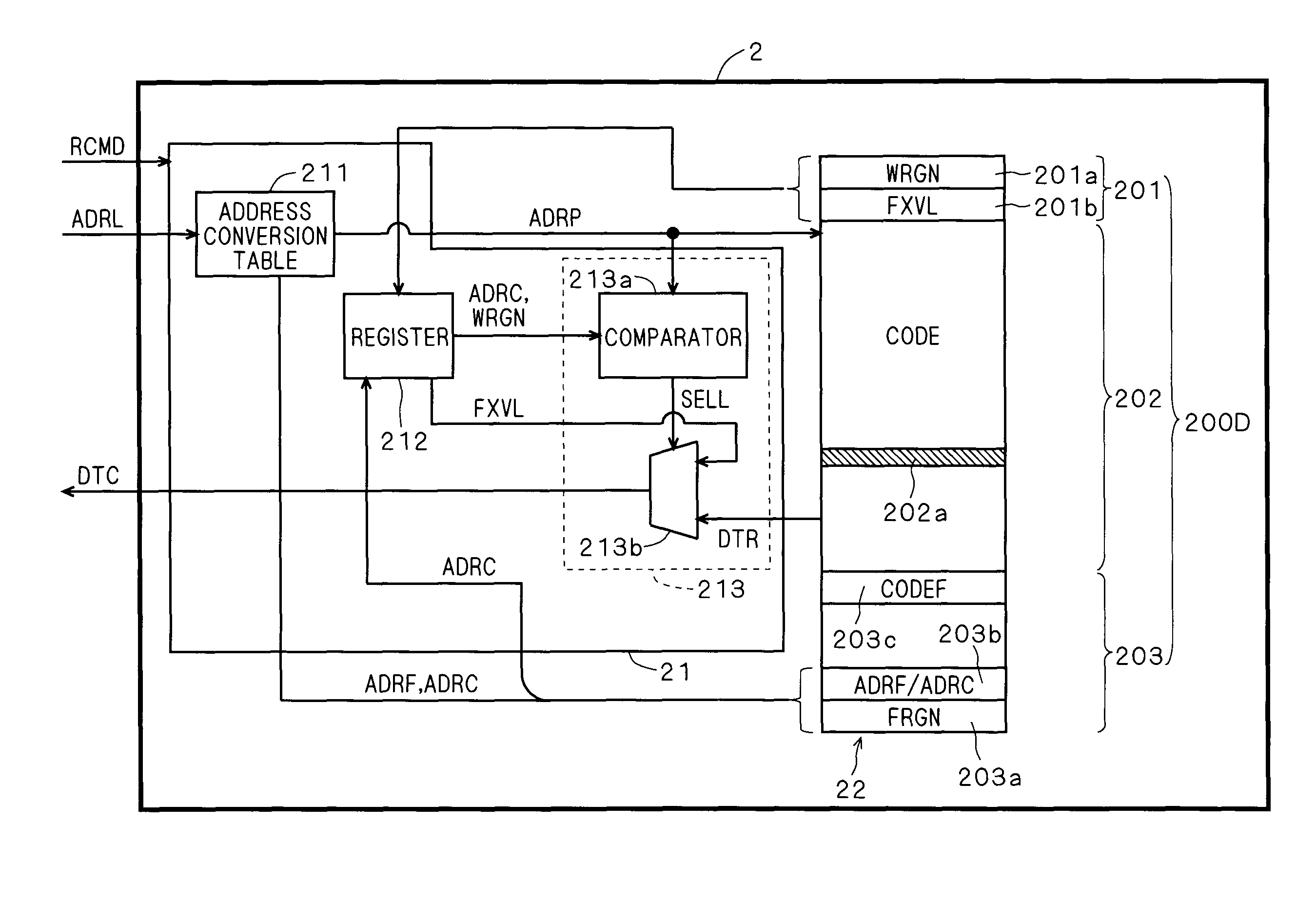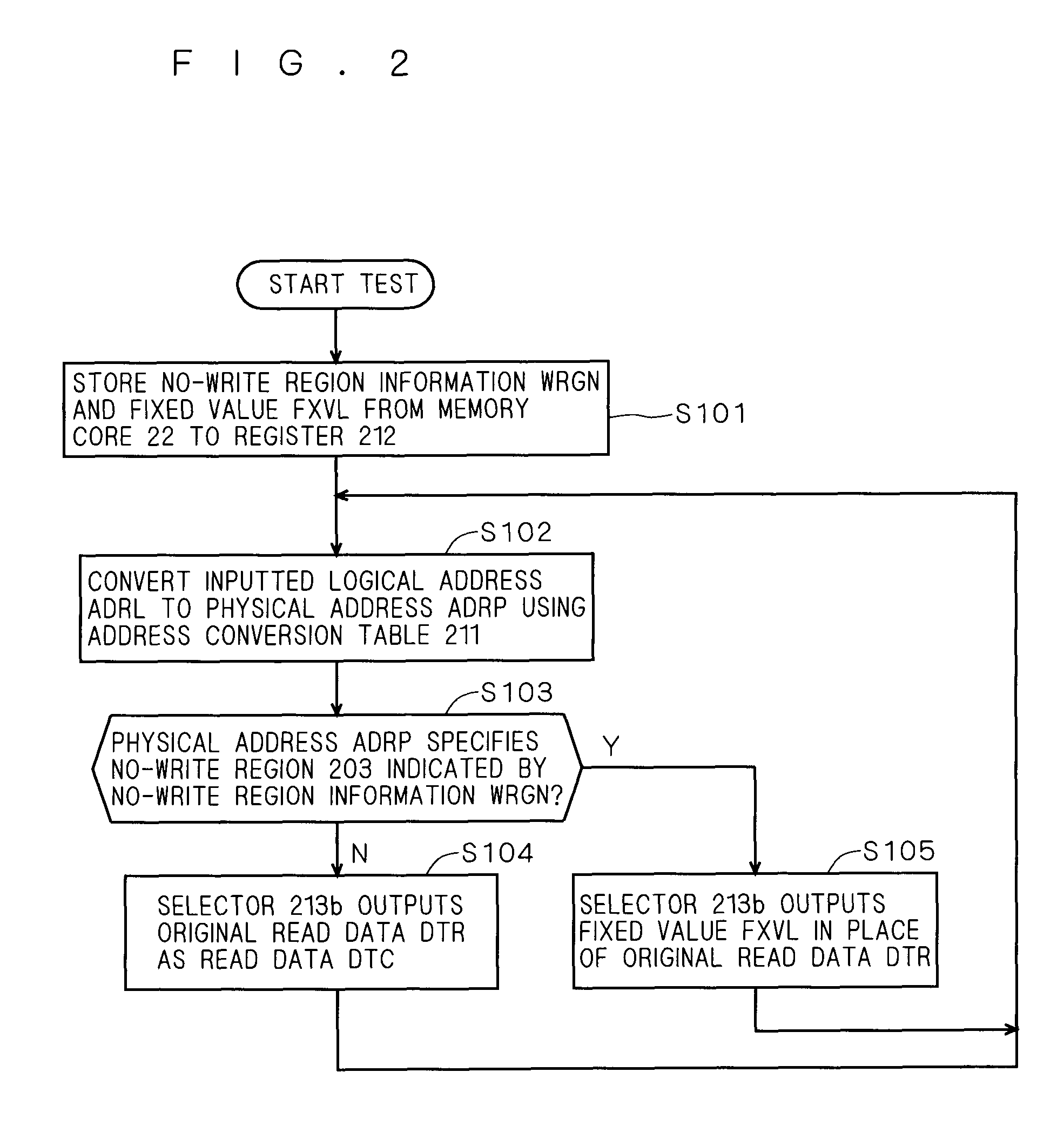Storage device and data output circuit
a storage device and data output technology, applied in memory adressing/allocation/relocation, instruments, program control, etc., can solve the problems of troublesome job, troublesome job, long manufacturing time, etc., and achieve the effect of simplifying the manufacturing process
- Summary
- Abstract
- Description
- Claims
- Application Information
AI Technical Summary
Benefits of technology
Problems solved by technology
Method used
Image
Examples
first preferred embodiment
[0046]FIG. 1 is a block diagram illustrating the configuration of a ROM 2 as a storage device according to a first preferred embodiment of the present invention. The ROM 2 includes a controller 21 and a memory core 22.
[0047]The memory core 22 is indicated with an address space 200C. The address space 200C includes an information storage region 201, a code region 202, and a no-write region 203. The information storage region 201 includes a first region 201a in which no-write region information WRGN is written, and a second region 201b in which a fixed value FXVL is written. Program code CODE is written in the code region 202. It is not necessary to apply an active write operation to the no-write region 203, and unknown values NC exist there.
[0048]The no-write region information WRGN indicates the position of the no-write region 203, or specifically physical addresses in the address space 200C, and the fixed value FXVL indicates a fixed value that is intended to be written to the no-w...
second preferred embodiment
[0062]The technique described in the first preferred embodiment can be applied to provide a so-called redundancy region in the no-write region 203. This is because the ROM 2 can be regarded as storing the fixed value FXVL in the no-write region 203, irrespective of the values actually stored in the no-write region 203.
[0063]FIG. 3 is a block diagram illustrating the configuration of a ROM 2 as a storage device according to a second preferred embodiment of the present invention. The configuration adopts the block shown in the first preferred embodiment, but signals are differently sent and received in some ways.
[0064]For a first difference, the address space 200C is replaced by an address space 200D. The address space 200D includes a redundancy indication region 203a, a redundancy conversion region 203b, and a redundancy region 203c that are provided in the no-write region 203.
[0065]The redundancy indication region 203a stores redundancy indication information FRGN that indicates the...
third preferred embodiment
[0091]The specification 100 of a ROM to which program code is written is not always provided in the form as illustrated in FIG. 12. FIG. 6 is a diagram conceptually showing another example of the specification 100. This specification 100 simply specifies logical addresses and a group of data DATA to be stored at the logical addresses. FIG. 7 is a diagram conceptually illustrating the contents of the data group DATA. Program code CODE1 and a fixed value group VL1 are located at different addresses. The fixed value group VL1 is a collection of fixed values FXVL.
[0092]When the specification 100 is provided in such a form, the no-write region information WRGN indicating the position of the fixed value group VL1 and the constituent fixed values FXVL are obtained by scanning the entirety of the data group DATA.
[0093]Since the specification does not specify addresses for storing the no-write region information WRGN and fixed values FXVL, the no-write region information WRGN and fixed value...
PUM
 Login to View More
Login to View More Abstract
Description
Claims
Application Information
 Login to View More
Login to View More - R&D
- Intellectual Property
- Life Sciences
- Materials
- Tech Scout
- Unparalleled Data Quality
- Higher Quality Content
- 60% Fewer Hallucinations
Browse by: Latest US Patents, China's latest patents, Technical Efficacy Thesaurus, Application Domain, Technology Topic, Popular Technical Reports.
© 2025 PatSnap. All rights reserved.Legal|Privacy policy|Modern Slavery Act Transparency Statement|Sitemap|About US| Contact US: help@patsnap.com



